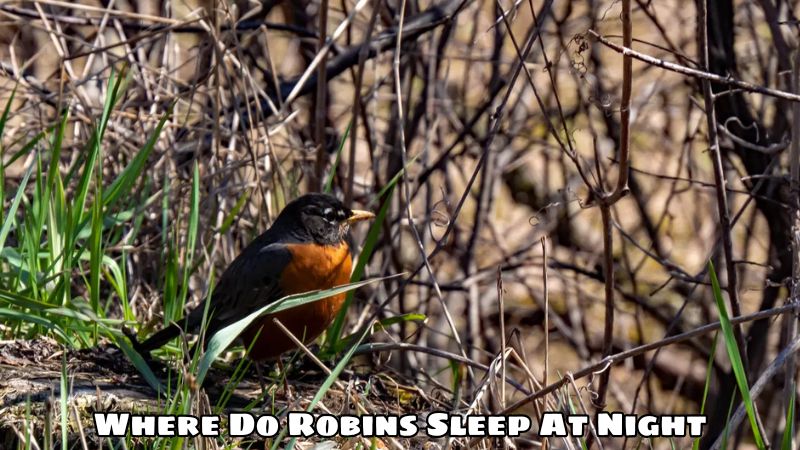The robin, a bustling songbird with brilliant plumage and melodious song, contains many interesting things that not everyone knows. One of the mysteries that attracts the curiosity of many bird lovers is: Where do robins sleep at night?
These birds fly across the sky, singing loudly, but when night falls, they disappear. Do they hide in dense trees, or go to secret caves to rest? Or is there another secret that we haven’t discovered yet? Join Exoticbirdscorner to discover interesting mysteries about robin sleep and expand your knowledge about this beautiful bird!
Where do robins sleep at night?
Where do robins sleep at night? The robin (scientific name: Turdus ruficollis), also known as the purple-necked robin or fire-crested robin, is a popular songbird in Vietnam and many other areas of the world.
They are popular for their outstanding appearance with bright red feathers on the neck and chest, contrasting with jet black feathers on the head, back and wings. The robin possesses a melodious song, often heard in the early morning and at dusk, bringing people moments of relaxation and peace.
This bird is medium sized, with a body length of about 20-23 cm. They often live in deciduous forests, mixed forests, orchards and even suburban areas of cities. Robins are omnivorous birds, their food includes fruits, insects, earthworms and other small animals.
Although widely distributed and easily adaptable to new habitats, the number of robins is on the decline due to hunting and habitat loss. Protecting and breeding this bird is essential to maintain biodiversity and preserve natural beauty.
The interesting thing about robins is that they have the ability to fly very far, traveling thousands of kilometers each year to avoid the cold. So, at night when not moving, where do robins sleep? Do they sleep on tree branches like other birds or do they have other special sleeping habits? This is an interesting question that many bird lovers are interested in and want to learn about.
To answer this question, we need to do more research on the sleeping habits of robins in the natural environment and when they are kept in captivity. Understanding the sleeping habits of birds will help us take better care of birds and protect their health.

Popular nighttime roosting spot for robins
Robins, a songbird famous for its brilliant plumage and melodious song, often choose safe and discreet shelters to rest at night. Here are two popular locations that robins frequent:
1. Trees
- Tall tree branches, thick canopy: Robins often choose tall tree branches, thick canopy as shelter. This position helps them shield themselves from enemies and weather elements such as rain, wind, and frost.
- Hidden, less visible locations: Robins often choose hidden locations in the tree canopy, less visible to protect themselves from detection by predators. They can sleep in groups or singly depending on environmental conditions and the number of individuals in the area.
2. Tree hole:
- Safe environment: Tree hollows provide robins with a safe, sheltered and warm environment to rest at night. Tree hollows help protect birds from predators and harmful agents from the outside environment.
- Suitable for female birds to incubate eggs and young birds: Tree holes are ideal places for female birds to incubate eggs and young birds to take shelter. This position helps protect the baby bird from potential dangers and creates conditions for the bird to develop safely.
However, due to the limited number of suitable tree holes, not all robins can choose this shelter. Therefore, robins often use high tree branches and thick canopy as their main sleeping place.
In addition to the above two popular locations, robins can also hide in other places such as roofs, caves, or even in dense bushes. The choice of a specific shelter depends on habitat conditions, the number of individual birds in the area and the individual behavior of each bird.
Understanding the robin’s habitat helps us better protect and care for this beautiful bird. Creating a safe living environment and providing enough food sources for birds will contribute to preserving and growing the number of robins in the wild.
Factors affecting the robin’s roosting location
A robin’s choice of where to roost at night depends on many different factors, including weather conditions, enemies, and the individual behavior of each bird.
1. Weather conditions
- Rain and wind: On rainy and windy days, robins can find more private shelters such as caves, roofs or dense trees to avoid being affected by bad weather.
- Cold weather: When it’s cold, robins often gather in flocks to warm each other. Huddling helps birds conserve energy and keep their bodies warm in cold environments.
2. Enemies
- Potential dangers: Robins are natural birds, so they always face danger from predators such as owls, snakes, weasels, etc. Therefore, birds often choose places to sleep. high and difficult to reach to avoid being attacked.
- Changing sleeping places: Some robins can change their sleeping places frequently to prevent danger. Continuous movement helps birds minimize the risk of being detected by predators.
3. Personal behavior
- Preferences: Each robin may have its own preference for choosing a sleeping place. Some animals like to sleep on high tree branches, while others prefer to sleep in tree hollows or dense bushes.
- Number of individuals: If the number of robins in the living area is large, they may gather to sleep together to increase safety and protect each other.
Sleeping behavior of robins
The robin, a songbird famous for its brilliant plumage and melodious song, possesses unique sleeping behaviors to ensure safety and keep its body warm in the dark.
1. Sleeping position
- Pulling its neck and folding its head to its chest: When sleeping, robins often retract their necks and fold their heads to their chest to keep their bodies warm, especially the head and neck, which are parts that easily lose heat.
- Bend one leg: The robin often bends one leg and clings tightly to the tree branch with the other three legs to maintain balance and avoid falling from the branch while sleeping.
2. Sleep time
- Sleeping at night: Robins are birds that are active during the day and sleep at night. After sunset, birds will seek safe shelter and begin to sleep.
- Average sleep time: On average, robins sleep about 8-10 hours a day. However, the specific sleeping time may vary depending on environmental conditions, amount of food and health status of the bird.
3. Sleep status
- Deep sleep: Robins usually sleep quite deeply and are rarely awakened by surrounding noise. This helps birds save energy and ensure their body’s health.
- Waking up suddenly: However, robins can also wake up suddenly if they feel danger or there is an unusually loud noise. High vigilance helps birds protect themselves from predators and other threats.
The robin’s sleeping behavior is an important part of this bird’s life. Understanding these behaviors helps us better care for birds and protect them from potential dangers in their environment.
Epilogue
Understanding the robin’s shelter and sleeping behavior helps us better protect and care for this beautiful bird. Protecting habitat and creating safe conditions for birds will contribute to preserving and developing the number of robins in the wild.
Besides the knowledge that has been shared, there are still many interesting things about robins waiting for us to discover. Let’s continue to nurture our passion, expand our understanding and join hands to protect these little bird friends to add color to life.





